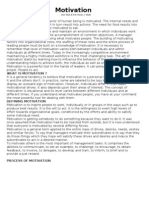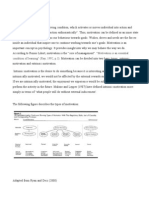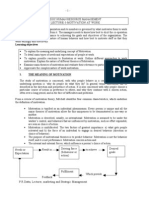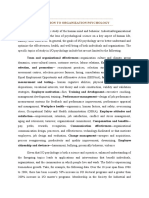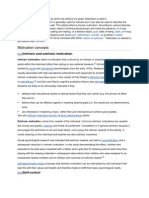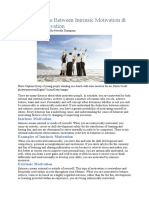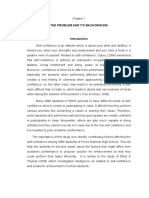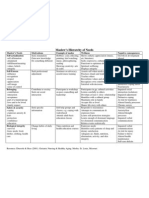Maslow's Theory
Maslow's Theory
Uploaded by
Jen SchnarrCopyright:
Available Formats
Maslow's Theory
Maslow's Theory
Uploaded by
Jen SchnarrOriginal Description:
Copyright
Available Formats
Share this document
Did you find this document useful?
Is this content inappropriate?
Copyright:
Available Formats
Maslow's Theory
Maslow's Theory
Uploaded by
Jen SchnarrCopyright:
Available Formats
Fundamentals of Management
ABRAHAM MASLOW
Abraham Harold Maslow was born April 1, 1908 in Brooklyn, New York. He first studied law at the City College of New York, (CCNY), transferred to Cornell, and then back to CCNY. He married Bertha Goodman, his first cousin and they had two daughters. He went on to attend the University of Wisconsin where he became interested in psychology. Maslow spent time there working with Harry Harlow, who is famous for his experiments with baby rhesus monkeys and attachment behavior.
1908-1970
He received his BA in 1930, his MA in 1931, and his PhD in 1934, all in psychology. He later returned to New York to work at Columbia University, where Maslow became interested in research on human sexuality. Maslow served as the chair of the psychology department at Brandeis University from 1951 to 1969 where he met Kurt Goldstein, who had originated the idea of self-actualization. He spent his final years in California, where he died on June 8 1970 of a heart attack.
MASLOWS THEORY OF MOTIVATION & HUMAN NEEDS
One of the many interesting things Maslow noticed while he worked with monkeys early in his career was that some needs take precedence over others. Maslow took this idea and created his now famous hierarchy of needs as illustrated below.
The basic concept is that the higher needs in this hierarchy only come into focus once all the needs that are lower down in the pyramid are mainly or entirely satisfied.
Fundamentals of Management The needs in his hierarchy from lowest to highest are as follows: Physiological Needs: Physiological needs are the basic needs required to sustain life such as: Air Water Nourishment Sleep
According to Maslow, higher needs such as social needs and self esteem are not felt until one has met the basic needs. Safety: Once physiological needs are met, ones attention turns to safety and security in order to be free from the threat of physical and emotional harm. Such needs might be fulfilled by: Living in a safe area Medical Insurance Job Security Financial Reserves
According to Maslow, if a person feels that he or she is in harms way higher needs will not receive much attention. Social Needs: Once a person has met the lower level physiological and safety needs, higher level needs become more important, the first of which are social needs. Social needs are those related to interaction with other people and may include: Need for friends Need for belonging Need to give and receive love
Esteem: Once a person feels a sense of belonging, the need to feel important arises. Esteem needs may be classified as internal or external. Internal esteem needs are those related to self-esteem such as self respect and achievement. External esteem needs are those such as social status and recognition. Some esteem needs are: Self respect Achievement Attention Recognition Reputation
Self Actualization: Self actualization is the highest level in Maslows hierarchy of needs. It is the quest of reaching ones full potential as a person. Unlike lower level needs, this need is never fully satisfied; as one grows psychologically there are always new opportunities to continue to grow. Self actualized people tend to have needs such as: Truth Justice Wisdom Meaning
According to Maslow, only as small percentage of the population ever reaches the level of self actualization.
Fundamentals of Management
Maslows legacy of work encompasses much more than just humanistic psychology, it extends into realms of business and management; the relationship between human behavior and the work situation.
THEORYS IMPLICATIONS FOR MANAGEMENT
Maslows theory has some important implications for management and can be applied to any organization. If effectively done, the organization can aim towards each individual achieving at maximum potential. There are opportunities to motivate employees through management style, job design, company events and compensation packages. Some examples follow: Physiological Needs: Provide lunch breaks, rest breaks, and wages that are sufficient to provide the essentials of life. Safety Needs: Provide a safe working environment, retirement benefits, and job security, health insurance. Social Needs: Create a sense of community via team-based projects and social events. Esteem Needs: Recognise achievements to make employees feel appreciated and valued. Offer job titles that convey the importance of the position. Self- Actualization: Provide employees a challenge and the opportunity to reach their full career potential. One thing to keep in mind is that not all people are driven by the same needs at any time different people may be motivated by entirely different factors. It is important to understand the needs being pursued by each employee. To motivate an employee, the manager must be able to recognize the needs level at which the employee is operating, and use those needs as levers of motivation. In conclusion, observing Maslow's hierarchy of needs can be a useful way for an organization to help their employees. Providing their personnel with an appropriate atmosphere will lead to the employee's development along the path towards self-actualization. REFERENCES 1. Maslow on Management 2. http://www.netmba.com 3. http://webspace.ship.edu/cgboer/maslow.html 4. http://academic.emporia.edu/smithwil/00fallmg443/eja/tuel.html 3
Fundamentals of Management 5. http://josephdamiano.com/Articles/workplace_motivation.html
You might also like
- Dark Psychology Secrets and ManipulationDocument443 pagesDark Psychology Secrets and ManipulationRossella Carosi80% (30)
- Three Theories of JusticeDocument27 pagesThree Theories of JusticeReza KhajeNo ratings yet
- Self ReflectionDocument14 pagesSelf Reflectionelder100% (2)
- How Globalization Affects HRMDocument6 pagesHow Globalization Affects HRMkashafchaudhry92% (12)
- 3.3 Motivation TheoriesDocument14 pages3.3 Motivation Theoriespriynka1990100% (3)
- Contribution of Abraham Maslow To OBDocument4 pagesContribution of Abraham Maslow To OBSairel MohammadNo ratings yet
- Hertzberg Theory of MotivationDocument6 pagesHertzberg Theory of MotivationAliNo ratings yet
- Victor VroomDocument9 pagesVictor VroomdyumnaNo ratings yet
- MotivationDocument12 pagesMotivationRehan SaleemNo ratings yet
- Evolution of Management ThoughtsDocument37 pagesEvolution of Management ThoughtsDebasmita SahaNo ratings yet
- MotivationDocument14 pagesMotivationDehaj100% (2)
- The Nature of PeopleDocument4 pagesThe Nature of PeopleArt FajardoNo ratings yet
- Maslow Hierarchy of NeedDocument13 pagesMaslow Hierarchy of NeedAbdul Wahab BobbyNo ratings yet
- Maslow's Hierarchy of NeedsDocument4 pagesMaslow's Hierarchy of NeedsibengNo ratings yet
- Intrinsic MotivationDocument4 pagesIntrinsic MotivationrimvarNo ratings yet
- Abraham MaslowDocument13 pagesAbraham Maslowfrediizee WinsNo ratings yet
- Abraham Maslow (1908-1970) : Humanistic-Existential Paradigm Self-Actualization TheoryDocument26 pagesAbraham Maslow (1908-1970) : Humanistic-Existential Paradigm Self-Actualization Theoryaa100% (1)
- Abraham Maslow's Hierarchy of NeedsDocument5 pagesAbraham Maslow's Hierarchy of NeedsKaizer Postrero100% (3)
- Motivation Theories: Management Training & Development LTDDocument7 pagesMotivation Theories: Management Training & Development LTDxxxfizaxxxNo ratings yet
- Leadership TraitsDocument3 pagesLeadership TraitsKorie ArsieNo ratings yet
- Motivation at WorkDocument8 pagesMotivation at WorkRadhika Batra100% (2)
- Are Motivations Theories, Culture-BasedDocument22 pagesAre Motivations Theories, Culture-Basedprincess julie ann bayogosNo ratings yet
- OB Individual AssignmentDocument21 pagesOB Individual AssignmentChen QingNo ratings yet
- Ob-Chapter 1Document6 pagesOb-Chapter 1Rajesh MgNo ratings yet
- Humanistic Theory SlideshowDocument30 pagesHumanistic Theory SlideshowAzim IsmailNo ratings yet
- Abraham MaslowDocument19 pagesAbraham Maslowneenu georgeNo ratings yet
- Maslow - Hierarchy of NeedsDocument8 pagesMaslow - Hierarchy of Needsgoldbowl97No ratings yet
- Maslows Hierarchy of NeedsDocument10 pagesMaslows Hierarchy of NeedsMandeep Singh100% (5)
- Structure of PersonalityDocument4 pagesStructure of PersonalityZoha ImranNo ratings yet
- Carl Rogers Theory of SelfDocument2 pagesCarl Rogers Theory of Selfdevtiwari2003100% (1)
- Process TheoryDocument9 pagesProcess Theorysamuelbeauchamp24No ratings yet
- Hellenistic Philosophy: Stoicism, Epicureanism, Hedonism, and CynicismDocument14 pagesHellenistic Philosophy: Stoicism, Epicureanism, Hedonism, and CynicismDanielle John V. MalonzoNo ratings yet
- Nature and Functions of HRMDocument13 pagesNature and Functions of HRMMinaxi SharmaNo ratings yet
- Social Psychology NotesDocument64 pagesSocial Psychology Notesfathima1991No ratings yet
- Human Relations Approach TheoriesDocument17 pagesHuman Relations Approach TheoriesSayam RoyNo ratings yet
- Modified Needs Hierarchy ModelDocument14 pagesModified Needs Hierarchy Modelkhalida khanNo ratings yet
- Introduction To Organizational PsychologyDocument34 pagesIntroduction To Organizational PsychologyGeena ThaplooNo ratings yet
- Career Planning & DevelopmentDocument27 pagesCareer Planning & DevelopmentAshutosh HarshvardhanNo ratings yet
- Employee Motivation Case StudyDocument4 pagesEmployee Motivation Case StudyLovepreetSidhu100% (1)
- Theoris of MotivationDocument18 pagesTheoris of MotivationtopherskiNo ratings yet
- Abraham Maslow 1Document6 pagesAbraham Maslow 1api-267620055No ratings yet
- On Organistaion BehaviourDocument31 pagesOn Organistaion Behaviourvanishachhabra5008100% (1)
- Human Relations MovementDocument3 pagesHuman Relations MovementRiya PhilipsNo ratings yet
- Role of Motivation in WorkplaceDocument23 pagesRole of Motivation in WorkplaceNazish SohailNo ratings yet
- MotivationDocument13 pagesMotivationTanmoy Das100% (1)
- Modern Theories of MotivationDocument8 pagesModern Theories of MotivationIrfan ShaikhNo ratings yet
- Case Study AnswerDocument10 pagesCase Study AnswerpreetimutiaraNo ratings yet
- Behavioral Management TheoryDocument2 pagesBehavioral Management TheoryrazrealNo ratings yet
- What Is PersonalityDocument14 pagesWhat Is Personalitybeth pranisaNo ratings yet
- KAREN HORNEY Psychoanalytic Social TheoryDocument8 pagesKAREN HORNEY Psychoanalytic Social TheoryJonathan SisonNo ratings yet
- Motivation and The Meaning of WorkDocument4 pagesMotivation and The Meaning of WorkRodrick Wilbroad100% (1)
- Power PowerDocument49 pagesPower Powersam cadleyNo ratings yet
- Theories of Management Assignment 1Document14 pagesTheories of Management Assignment 1papabaksNo ratings yet
- Types of PrsonalityDocument9 pagesTypes of PrsonalitySuraj IngaleNo ratings yet
- Personal Development PlanDocument1 pagePersonal Development PlanSedrat AlmontahaNo ratings yet
- Theory of X and YDocument3 pagesTheory of X and YMildred VillarubiaNo ratings yet
- Intrinsic and Extrinsic MotivationDocument2 pagesIntrinsic and Extrinsic MotivationYashoda Satpute100% (1)
- Esteem Needs: Truth Justice Wisdom MeaningDocument3 pagesEsteem Needs: Truth Justice Wisdom MeaningAnuraj AroraNo ratings yet
- Maslow's Hierarchy Theory: Needs), and The Top Level Is Known As Growth or Being Needs (B-Needs)Document12 pagesMaslow's Hierarchy Theory: Needs), and The Top Level Is Known As Growth or Being Needs (B-Needs)Suresh Kutty MNo ratings yet
- Motivation TheoriesDocument15 pagesMotivation TheoriesFahd Ȝziz EldienNo ratings yet
- Motivation Theories: Figure 1. Motivation Theories (Source: Author's Own Figure)Document15 pagesMotivation Theories: Figure 1. Motivation Theories (Source: Author's Own Figure)Keshav Kumar SharmaNo ratings yet
- Makerere University Business School Bachelor of Entreprenuership and Small Business Management Human Behavior at Work Course Work 2Document10 pagesMakerere University Business School Bachelor of Entreprenuership and Small Business Management Human Behavior at Work Course Work 2asdddadaweeewerNo ratings yet
- Chapter 2Document17 pagesChapter 2Caryl Jean GomezNo ratings yet
- 5 Steps To Mental WellbeingDocument3 pages5 Steps To Mental WellbeingAdoree RamosNo ratings yet
- Reviewer For MODULE 2 - CWTSDocument7 pagesReviewer For MODULE 2 - CWTSPatrick John AvilaNo ratings yet
- Adolescent Self EsteemDocument8 pagesAdolescent Self EsteemDavid JovkovskiNo ratings yet
- Stress-Related Anxiety DisordersDocument13 pagesStress-Related Anxiety DisordersPatrick Ross Serquiña DulayNo ratings yet
- 06 RE-ENCOUNTER - LESSON (English)Document13 pages06 RE-ENCOUNTER - LESSON (English)Roma Amor FelicianoNo ratings yet
- Abraham Harold Maslow Was An American PsychologistDocument8 pagesAbraham Harold Maslow Was An American Psychologistmarz sidNo ratings yet
- Physical SelfDocument43 pagesPhysical SelfKevin Paul TabiraoNo ratings yet
- Chapter 4 Self in Allied ScienceDocument18 pagesChapter 4 Self in Allied ScienceSharmaine Gatchalian BonifacioNo ratings yet
- Salinan Terjemahan 925-1959-1-SMDocument22 pagesSalinan Terjemahan 925-1959-1-SMfatmah rifathNo ratings yet
- Elc550 Term Paper DraftDocument5 pagesElc550 Term Paper DraftAllisya NasirNo ratings yet
- Cingeletal COiPDocument21 pagesCingeletal COiPMakanudo.No ratings yet
- Module 1-Physical SelfDocument5 pagesModule 1-Physical SelfTinay Ledesma Gepetacio100% (1)
- Contributing Factors Zffecting The Self-Confidence of Abm Students in PNHSDocument8 pagesContributing Factors Zffecting The Self-Confidence of Abm Students in PNHSAndried AquinoNo ratings yet
- What Is Emotional IntelligenceDocument11 pagesWhat Is Emotional IntelligenceangelicaNo ratings yet
- Attribution TheoryDocument15 pagesAttribution Theorybayar2233No ratings yet
- For PlagiarismDocument56 pagesFor PlagiarismZynav FaciolanNo ratings yet
- Talle - 2023 Autoestima y Rendimiento AcademicoDocument8 pagesTalle - 2023 Autoestima y Rendimiento AcademicoEduardo AntonioNo ratings yet
- How To Overcome Anxious Attachment - Google SearchDocument1 pageHow To Overcome Anxious Attachment - Google Searchkuallya95No ratings yet
- Overcoming Insecurity and Low Self Esteem Mindworks A Practical PDF FreeDocument4 pagesOvercoming Insecurity and Low Self Esteem Mindworks A Practical PDF FreeArun Prasath ManoharanNo ratings yet
- Empires of Mind Group 6Document18 pagesEmpires of Mind Group 6Rohan PaiNo ratings yet
- Goleman Emotional Intelligence QuestionnaireDocument3 pagesGoleman Emotional Intelligence Questionnairetwydvg89m6No ratings yet
- Maureal - Quarter 2 Written Work 2.1Document4 pagesMaureal - Quarter 2 Written Work 2.1Seth MaurealNo ratings yet
- Maslow ChartDocument1 pageMaslow Chartcbt878No ratings yet
- Montessori Theory - A Beginners GuideDocument18 pagesMontessori Theory - A Beginners GuideAprendizaje2022 INSPT-UTNNo ratings yet
- UTS NotesDocument17 pagesUTS Notesartisticjamie202No ratings yet
- 40 Developmental Assets: Building Blocks That Help Young Children Grow Up Healthy, Caring and ResponsibleDocument15 pages40 Developmental Assets: Building Blocks That Help Young Children Grow Up Healthy, Caring and Responsibletori1224No ratings yet
- Chakra Test ResultsDocument16 pagesChakra Test Resultsminjacob_601721240No ratings yet








